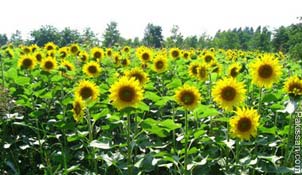|
 THE
farmers in seven flood-hit districts of Sindh are estimated
to earn about Rs3.149 billion from sunflower, according to
sources in institutions that supported cultivation of this
mid-season crop. THE
farmers in seven flood-hit districts of Sindh are estimated
to earn about Rs3.149 billion from sunflower, according to
sources in institutions that supported cultivation of this
mid-season crop.
Sunflower was cultivated in Jacobabad, Qambar Shahdadkot,
Shikarpur, Kashmore-Kandhkot, Larkana and Dadu in upper
Sindh and Thatta in lower Sindh on 95,444 acres with a
reckoned average per acre yield of 15 maunds and
province-wide harvest of 1,431,660 maunds.
According to market reports, the farmers are selling their
produce at Rs2,200 per 40 kg, that is more than the official
support price of Rs2,000, due to high international prices
and high domestic demand.
Each beneficiary, who was otherwise affected by the floods
and rendered homeless and shelterless, may get Rs60,000 to
Rs70,000 from sale proceeds of sunflower.
This US-assisted initiative called Sindh Agriculture
Recovery Project (SARP), was launched in December 2010, to
help the IDPs/ flood affected people to grow sunflower.
The sunflower can bridge the seasonal gap between harvesting
and plantation of paddy next season. Earlier, wheat or some
other crops was grown. Sunflower has the potential for
playing a major role in substituting import of edible oil.
It was first time that a third (mid season) crop sunflower –
was cultivated in Sindh moist-laden soil hit by floods.
Hence the yield per acre was not satisfactory and estimated
targets were not met.
In upper Sindh only two crops paddy and wheat – were
cultivated and the overall wheat output used to be low,
forcing growers of these districts to explore other options
to improve their financial conditions. They can now bank on
additional incomes from sunflower.
Initially, growers faced problems in marketing of sunflower
but with coordinated efforts of SARP and representative
farmers organizations, these problems are being overcome.
Assisted by USAID, SARP was launched in partnership with the
Rural Support Programmes Network, Sindh Rural Support
Organisation and Sindh Abadgar Board (SAB). The total value
of this project was $15 million that covered 84 union
councils.
Agricultural inputs were provided to flood-affected small
farmers. The target beneficiaries stated to be 50,575 small
farmers having land holdings up to 20 acres.
The package of support included: certified sunflower seed,
fertilisers (DAP and urea), trainings on sunflowers
cultivation and cash packages for land preparation, cash for
on-farm (water courses repair) and threshing.
After the refusal of solvent plant owners to establish their
procurement centres at district headquarters, the grain
merchants, retailers and traders agreed to purchase
sunflower, if brought by the farmers to the grain markets of
the respective districts. This mechanism worked and the
farmers formed clusters at each UC level. As for threshing,
some growers have purchased the sunflower threshers,
particularly in Shikarpur while some solvent plants provided
threshers to the beneficiaries of various districts.
Courtesy: DAWN
|
Pakissan.com;
|